Over the past decade, especially in the last five or six years, there has been a widespread move by contractors from trailed mowers to front and rear mounted set-ups.
Ten years ago, a lot of contractors would have been running 140-150hp tractors, but today many are running at least one, if not several, 180-200hp tractors.
With the cost of machinery and the difficulty in finding skilled staff, running two mowers on one modern medium-sized tractor is a more efficient solution for many Irish contractors.
Manufacturers and dealers have recognised this, and have played a large role in the trend towards the two-mower combinations. One Irish manufacturer growing year-on-year in this space is Malone Farm Machinery.
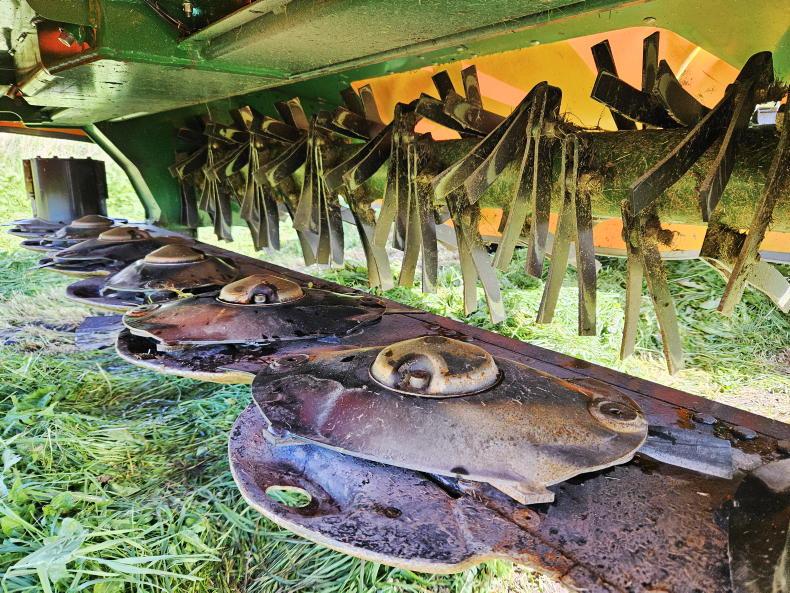
Both the front mower and rear mowers were fitted with a seven-disc heavy duty cutter bar.
The Mayo company started building its Procut rear mounted belt-driven mowers in 2008, and today offers a complete front and rear mounted and trailed conditioner and non-conditioner mower line-up.
In recent years, the focus has been on building shaft-driven centre pivot mowers targeted at larger farmers and contractors. The only obvious exclusion from the line-up are rear butterfly mowers, which the Irish Farmers Journal understands are currently being fabricated and due out for testing this coming season.
After five seasons of design and testing, Malone Farm Machinery officially launched its 3000 FC 3m front conditioner mower at the National Ploughing Championships last September.
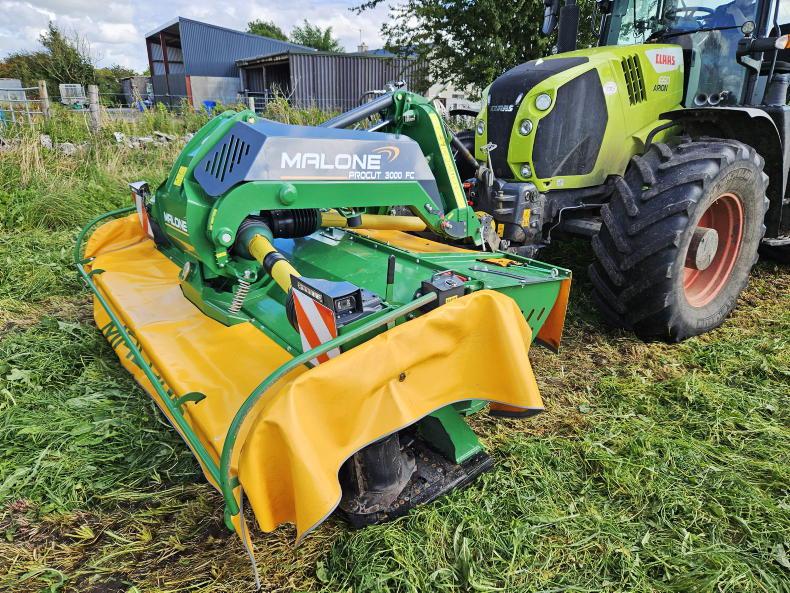
The new 3000 FC is a pull type mower that features hydraulic suspension.
The mower obviously complements its existing rear side mounted models, in particular the 3m 3000 MC conditioner model, which was launched in the past few years.
First impressions
At a first glance the mower combination seems to be well built and well presented.
One of the biggest issues that farmers and contractors have when it comes to rear mounted mowers is weight.
Looking at some popular competitor mowers sold here in Ireland such as Krone, McHale, Kverneland and SIP, their weight ranges from 1,150kg up to 1,470kg. The Malone 3000 MC rear mounted conditioner model we tried out weighs in at 1,360kg.
In terms of the front mower, Malone opted for a ‘pull-type’ system with a hydraulic floatation setup. Its ground following ability was the major stand out feature that really impressed us.
Reputable components
Malone use reputable components in their mowers, such as Comer gearboxes and cutter bars and Walterscheid drive-line components.
Both the front mower and rear mowers are
fitted with a seven-disc heavy duty cutter bar. The two outside discs on each bed rotate clockwise towards the centre.
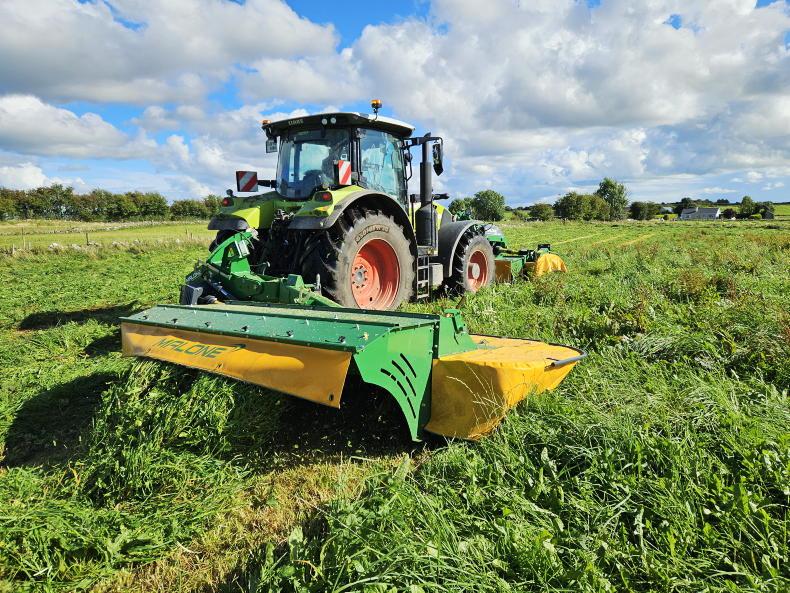
The rear mower features one single-acting ram for the bed suspension system and one double-acting ram for raising and lowering the bed.
The bed is fitted with 25mm gears and Comer’s shear hub protection system.
Labelled as a drive shield module, it consists of a gear and shaft. At the bottom of the shaft is a groove that is designed to shear if it comes under excess pressure, for example, if the hub collides with a foreign object such as a stone.
Malone advises farmers/contractors to have a spare hub on the shelf – replacement involves removing six bolts and placing the hub at 90 degrees to the two adjacent discs.
Although we never ran into this kind of trouble when using the mowers, Malone says it’s a 20-30 minute job. This is a similar system used today by many mower manufacturers.
For a longer life, the cutter bar now comes as standard with 6mm hardox wear plates that are bolted onto the bottom of the stone guards underneath the cutter bar.
As mentioned, the bed features seven discs with seven stones guards, so seven wear slides are fitted. Malone first began using quick-fit blades five years ago, and these are now fitted as standard, leaving blade replacement relatively pain-free using the tool provided. Each disc is fitted with 4mm thick cranked blades.
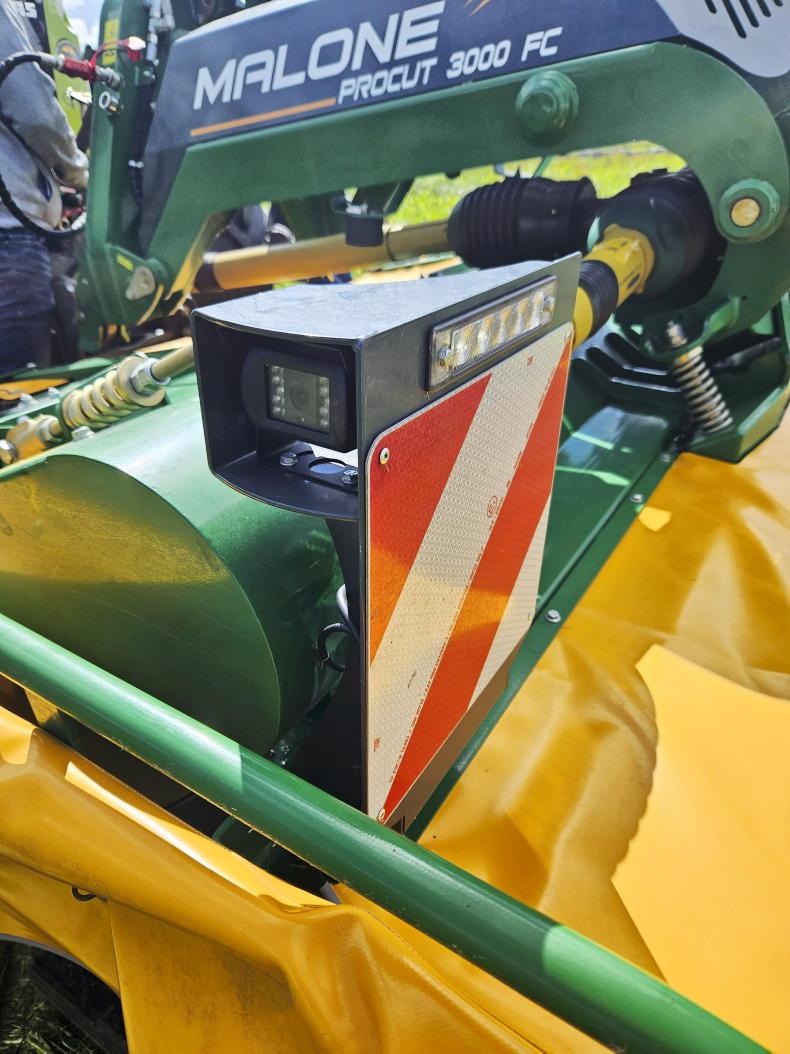
As an optional extra, Malone is offering a built-in blind spot assist camera system.
Folding covers means the cutter bar is easy to access. As mentioned, the 1,000rpm heavy-duty driveline has been provided by the well-known supplier,
Walterscheid. The PTO is equipped with
a slip clutch ahead of the main 90°
gearbox.
Front mower design
When designing the new front mower, Malone studied both push and pull type mower designs with a variation of spring and hydraulic suspension.
It opted to go down the route of a pull type system with its new 3000 FC. It also chose hydraulic suspension, as it felt this offered the best ground following ability. The hydraulic suspension system requires two single acting hydraulic spools with one float position. The front mower weighs in at 1,200kg.
The mower also features pendulum type suspension, with 16 degrees travel to both the left and the right. In line with some mower manufacturers such as Claas, Malone opted for three-point attachment over a quick attach A-frame.
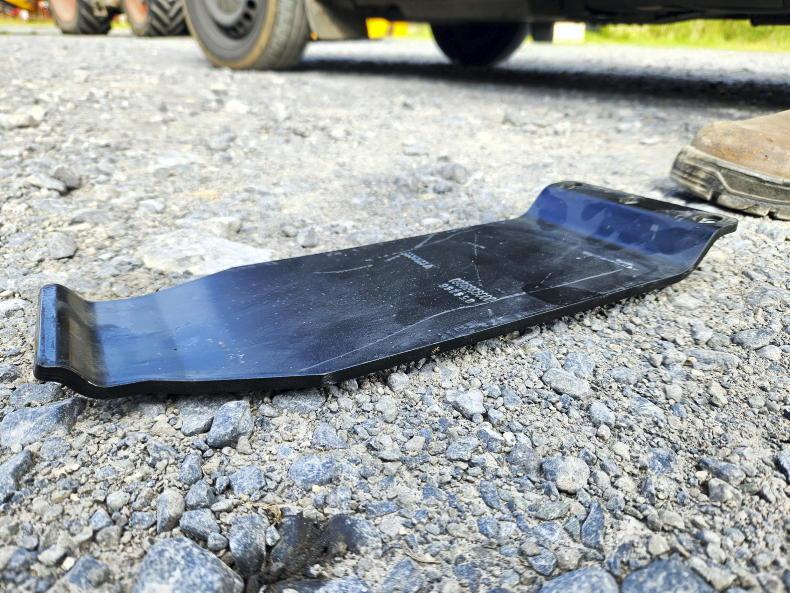
The cutter bar comes with the option of 6mm hardox wear plates that bolt onto the bottom of the stone guards underneath the cutter bar, for users who would be cutting large acreages.
This means that when the mower is mounted for road and mowing, the front linkage never moves. Instead, the operator raises and lowers the mower using the hydraulics.
The mower comes with a total one metre range of travel, 500mm upwards and 500mm downwards, allowing it to navigate through hills and hollows.
With safety in mind, Malone initially looked at fitting mirrors on the front mower to assist the driver in viewing any oncoming cars when pulling out onto the road from a field or a side road.
As an optional extra, it is offering a built-in blind spot assist camera system. Two cameras, one to each side of the mower, are neatly tucked away inside the light frame.
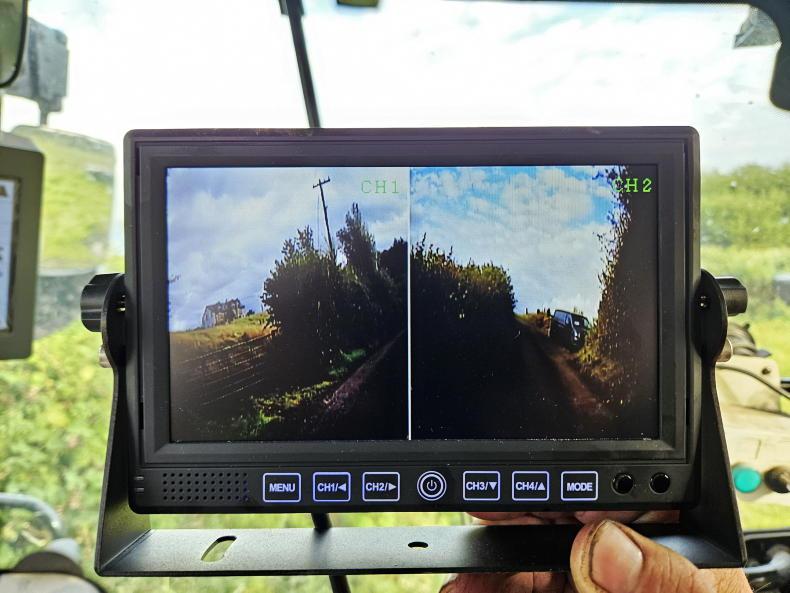
The two images are transmitted to the screen in the cab, which gives the driver a full view of the road, which he/she is pulling out onto.
The two images are transmitted to the screen in the cab, which gives the driver a full view of the road, which he/she is pulling out onto.
Rear mower
The neat frame of the 3000 MC incorporates a simple, effective main pivot linkage and break back protection system. Each side of the headstock features two mounting points for the lift arms. The thinking behind this is to allow the mower to run 250mm offset for an increased overlap when it is coupled with a front mower.
When the mower is in its upright position, a rope is used to release the mechanical two stage latch from its locked position. Once in the field and in the working position, the beds on the front and rear mowers needs to be pressurised to for optimum ground following.
The rear mower features one single-acting ram for the bed suspension system and one double-acting ram for raising and lowering the bed.
The single-acting service line is fitted with a tap valve so that once bed pressure is set, the tap can be shut off and the pressure retained.
A mechanical depth gauge helps determine the working height of the mower bed, but users should charge them to 70-80 bar pressure.
The break-back protection system on the rear mower is designed to protect the bed in the event of a direct collision with an obstacle. Three groups of compressed domed washers hold the hinge-type break-back in its fixed position.
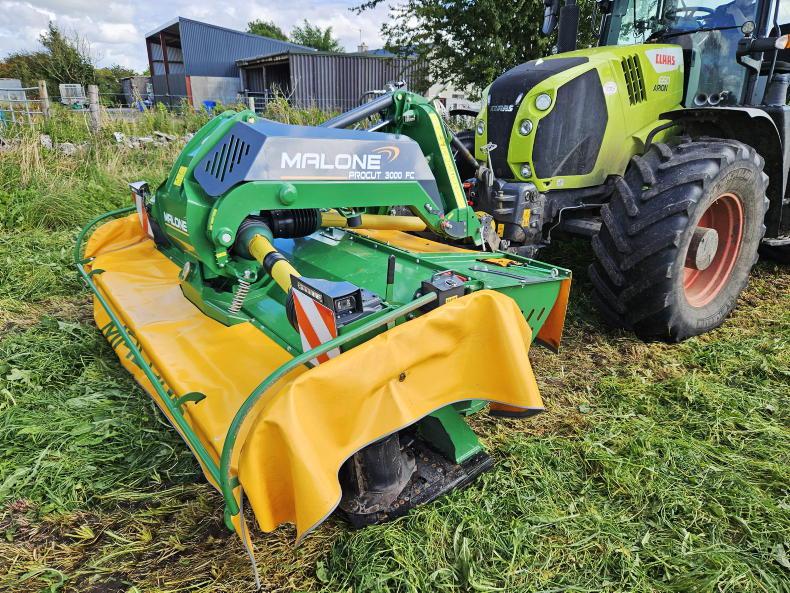
The front mower weighs in at 1,200kg.
A collision surpassing the preset force engages the break-back feature, and causes the mower to swing back and upwards, out of harm’s way.
When it comes to transport, the mower is folded back, and sits almost diagonally at 115°. The mower sits into a nylon plated V-groove, where it is locked into position via a two-stage latch. The transport lock is simple and effective.
Conditioner
Both the front and rear mowers are equipped with semi-swing steel tine conditioners. The tines are bolted onto a hardox plate, which is welded onto the conditioner for a long life.
The conditioner runs on heavy duty bearings, which are belt driven using a deep groove single section four banded belt. The conditioner runs at a fixed speed of 805rpm, but users can adjust the rear baffle door. With three levels of adjustment, it affects the aggressiveness of conditioning. The most inner
setting offers aggressive conditioning, while the most outer setting offers
minimal conditioning, and almost lets the grass out flat. The width of the swath can also be modified, using the gates at the rear.
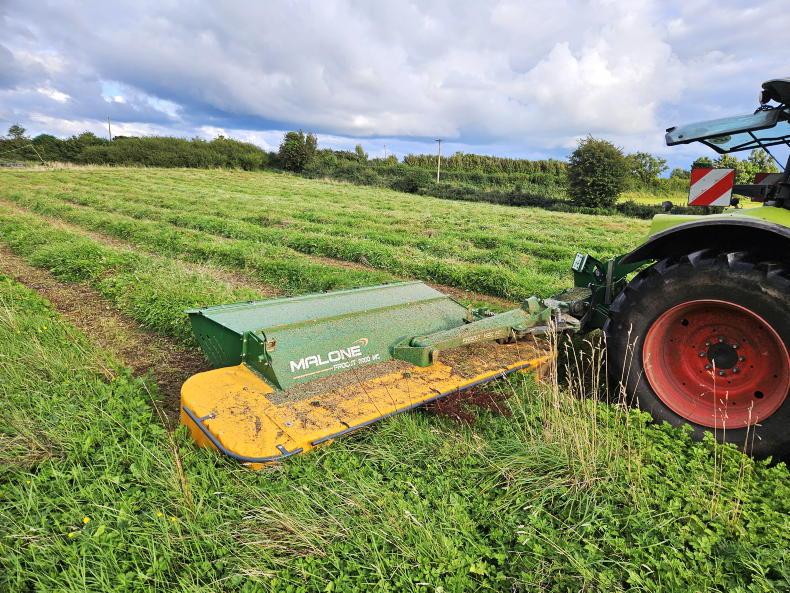
Both the front and rear mowers are equipped with semi-swing steel tine conditioners.
Over the past decade, especially in the last five or six years, there has been a widespread move by contractors from trailed mowers to front and rear mounted set-ups.
Ten years ago, a lot of contractors would have been running 140-150hp tractors, but today many are running at least one, if not several, 180-200hp tractors.
With the cost of machinery and the difficulty in finding skilled staff, running two mowers on one modern medium-sized tractor is a more efficient solution for many Irish contractors.
Manufacturers and dealers have recognised this, and have played a large role in the trend towards the two-mower combinations. One Irish manufacturer growing year-on-year in this space is Malone Farm Machinery.

Both the front mower and rear mowers were fitted with a seven-disc heavy duty cutter bar.
The Mayo company started building its Procut rear mounted belt-driven mowers in 2008, and today offers a complete front and rear mounted and trailed conditioner and non-conditioner mower line-up.
In recent years, the focus has been on building shaft-driven centre pivot mowers targeted at larger farmers and contractors. The only obvious exclusion from the line-up are rear butterfly mowers, which the Irish Farmers Journal understands are currently being fabricated and due out for testing this coming season.
After five seasons of design and testing, Malone Farm Machinery officially launched its 3000 FC 3m front conditioner mower at the National Ploughing Championships last September.

The new 3000 FC is a pull type mower that features hydraulic suspension.
The mower obviously complements its existing rear side mounted models, in particular the 3m 3000 MC conditioner model, which was launched in the past few years.
First impressions
At a first glance the mower combination seems to be well built and well presented.
One of the biggest issues that farmers and contractors have when it comes to rear mounted mowers is weight.
Looking at some popular competitor mowers sold here in Ireland such as Krone, McHale, Kverneland and SIP, their weight ranges from 1,150kg up to 1,470kg. The Malone 3000 MC rear mounted conditioner model we tried out weighs in at 1,360kg.
In terms of the front mower, Malone opted for a ‘pull-type’ system with a hydraulic floatation setup. Its ground following ability was the major stand out feature that really impressed us.
Reputable components
Malone use reputable components in their mowers, such as Comer gearboxes and cutter bars and Walterscheid drive-line components.
Both the front mower and rear mowers are
fitted with a seven-disc heavy duty cutter bar. The two outside discs on each bed rotate clockwise towards the centre.

The rear mower features one single-acting ram for the bed suspension system and one double-acting ram for raising and lowering the bed.
The bed is fitted with 25mm gears and Comer’s shear hub protection system.
Labelled as a drive shield module, it consists of a gear and shaft. At the bottom of the shaft is a groove that is designed to shear if it comes under excess pressure, for example, if the hub collides with a foreign object such as a stone.
Malone advises farmers/contractors to have a spare hub on the shelf – replacement involves removing six bolts and placing the hub at 90 degrees to the two adjacent discs.
Although we never ran into this kind of trouble when using the mowers, Malone says it’s a 20-30 minute job. This is a similar system used today by many mower manufacturers.
For a longer life, the cutter bar now comes as standard with 6mm hardox wear plates that are bolted onto the bottom of the stone guards underneath the cutter bar.
As mentioned, the bed features seven discs with seven stones guards, so seven wear slides are fitted. Malone first began using quick-fit blades five years ago, and these are now fitted as standard, leaving blade replacement relatively pain-free using the tool provided. Each disc is fitted with 4mm thick cranked blades.

As an optional extra, Malone is offering a built-in blind spot assist camera system.
Folding covers means the cutter bar is easy to access. As mentioned, the 1,000rpm heavy-duty driveline has been provided by the well-known supplier,
Walterscheid. The PTO is equipped with
a slip clutch ahead of the main 90°
gearbox.
Front mower design
When designing the new front mower, Malone studied both push and pull type mower designs with a variation of spring and hydraulic suspension.
It opted to go down the route of a pull type system with its new 3000 FC. It also chose hydraulic suspension, as it felt this offered the best ground following ability. The hydraulic suspension system requires two single acting hydraulic spools with one float position. The front mower weighs in at 1,200kg.
The mower also features pendulum type suspension, with 16 degrees travel to both the left and the right. In line with some mower manufacturers such as Claas, Malone opted for three-point attachment over a quick attach A-frame.

The cutter bar comes with the option of 6mm hardox wear plates that bolt onto the bottom of the stone guards underneath the cutter bar, for users who would be cutting large acreages.
This means that when the mower is mounted for road and mowing, the front linkage never moves. Instead, the operator raises and lowers the mower using the hydraulics.
The mower comes with a total one metre range of travel, 500mm upwards and 500mm downwards, allowing it to navigate through hills and hollows.
With safety in mind, Malone initially looked at fitting mirrors on the front mower to assist the driver in viewing any oncoming cars when pulling out onto the road from a field or a side road.
As an optional extra, it is offering a built-in blind spot assist camera system. Two cameras, one to each side of the mower, are neatly tucked away inside the light frame.

The two images are transmitted to the screen in the cab, which gives the driver a full view of the road, which he/she is pulling out onto.
The two images are transmitted to the screen in the cab, which gives the driver a full view of the road, which he/she is pulling out onto.
Rear mower
The neat frame of the 3000 MC incorporates a simple, effective main pivot linkage and break back protection system. Each side of the headstock features two mounting points for the lift arms. The thinking behind this is to allow the mower to run 250mm offset for an increased overlap when it is coupled with a front mower.
When the mower is in its upright position, a rope is used to release the mechanical two stage latch from its locked position. Once in the field and in the working position, the beds on the front and rear mowers needs to be pressurised to for optimum ground following.
The rear mower features one single-acting ram for the bed suspension system and one double-acting ram for raising and lowering the bed.
The single-acting service line is fitted with a tap valve so that once bed pressure is set, the tap can be shut off and the pressure retained.
A mechanical depth gauge helps determine the working height of the mower bed, but users should charge them to 70-80 bar pressure.
The break-back protection system on the rear mower is designed to protect the bed in the event of a direct collision with an obstacle. Three groups of compressed domed washers hold the hinge-type break-back in its fixed position.

The front mower weighs in at 1,200kg.
A collision surpassing the preset force engages the break-back feature, and causes the mower to swing back and upwards, out of harm’s way.
When it comes to transport, the mower is folded back, and sits almost diagonally at 115°. The mower sits into a nylon plated V-groove, where it is locked into position via a two-stage latch. The transport lock is simple and effective.
Conditioner
Both the front and rear mowers are equipped with semi-swing steel tine conditioners. The tines are bolted onto a hardox plate, which is welded onto the conditioner for a long life.
The conditioner runs on heavy duty bearings, which are belt driven using a deep groove single section four banded belt. The conditioner runs at a fixed speed of 805rpm, but users can adjust the rear baffle door. With three levels of adjustment, it affects the aggressiveness of conditioning. The most inner
setting offers aggressive conditioning, while the most outer setting offers
minimal conditioning, and almost lets the grass out flat. The width of the swath can also be modified, using the gates at the rear.

Both the front and rear mowers are equipped with semi-swing steel tine conditioners.









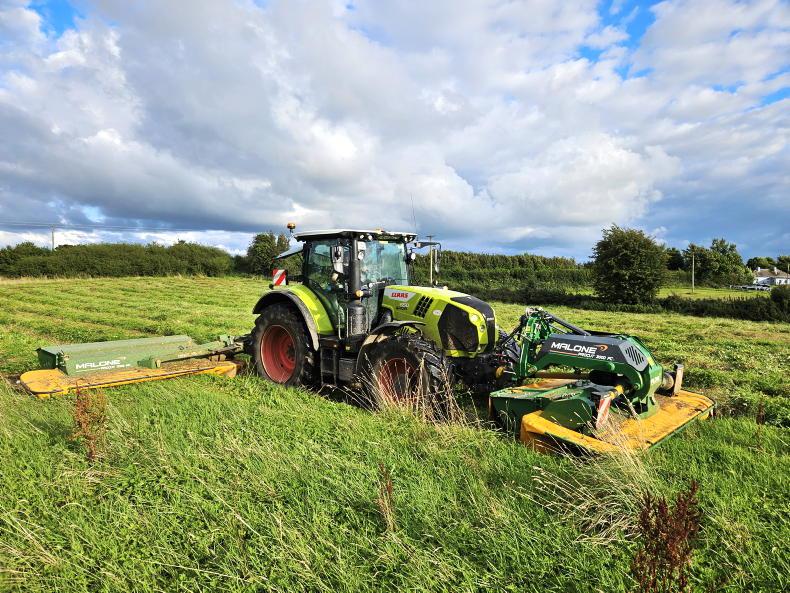





 This is a subscriber-only article
This is a subscriber-only article










SHARING OPTIONS: